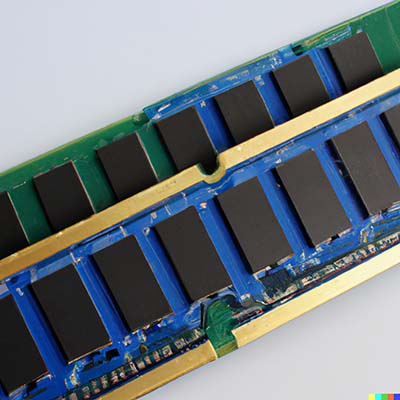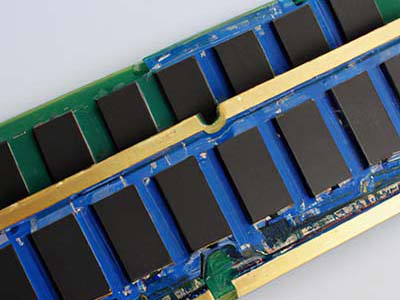DDR to DDR4 RAM Bus Speed and Data Transfer Rate
DDR to DDR4 RAM Bus Speed and Data Transfer Rate
 Random Access Memory (RAM) is a crucial component of a computer system. It temporarily stores data and applications that are in use, allowing the processor to access them quickly and efficiently. Over the years, several generations of RAM technology have been introduced, each with its own unique features and specifications. In this article, we will take a closer look at the five major types of RAM: DDR1, DDR2, DDR3, DDR4, and DDR5.
Random Access Memory (RAM) is a crucial component of a computer system. It temporarily stores data and applications that are in use, allowing the processor to access them quickly and efficiently. Over the years, several generations of RAM technology have been introduced, each with its own unique features and specifications. In this article, we will take a closer look at the five major types of RAM: DDR1, DDR2, DDR3, DDR4, and DDR5.
DDR1 (Double Data Rate Type 1)
Launched: 2000
Bus Speed: 200 – 266 MHz
Transfer Rate: 2.1 GB/s
Capacity: Up to 1 GB
Pin Count: 184
DDR1 was the first version of DDR (Double Data Rate) memory and the first major improvement over SDRAM (Single Data Rate Synchronous Dynamic RAM). It introduced the concept of “double pumping” the data bus, effectively doubling the amount of data transferred per clock cycle. DDR1 memory was widely used in the early days of the PC and was a standard feature in most desktop computers during the early 2000s.
DDR1 was the first version of DDR (Double Data Rate) memory and the first major improvement over SDRAM (Single Data Rate Synchronous Dynamic RAM). It introduced the concept of “double pumping” the data bus, effectively doubling the amount of data transferred per clock cycle. DDR1 memory was widely used in the early days of the PC and was a standard feature in most desktop computers during the early 2000s.
DDR2 (Double Data Rate Type 2)
Launched: 2003
Bus Speed: 400 – 533 MHz
Transfer Rate: 4.2 GB/s
Capacity: Up to 4 GB
Pin Count: 240
DDR2 was the next generation of DDR memory and brought several improvements over DDR1. It had higher bus speeds, improved efficiency, and increased capacity. DDR2 memory also introduced a more efficient bus signaling technology, reducing power consumption and increasing stability. DDR2 memory was widely used in desktop computers and laptops from the mid-2000s to the early 2010s.
DDR3 (Double Data Rate Type 3)
Launched: 2007
Bus Speed: 800 – 1600 MHz
Transfer Rate: 12.8 GB/s
Capacity: Up to 16 GB
Pin Count: 240
DDR3 represented a major leap forward in RAM technology and offered several key improvements over DDR2. It had much higher bus speeds, improved power efficiency, and increased capacity. DDR3 memory also introduced a new architecture that allowed for higher data rates while reducing power consumption. DDR3 memory was widely used in desktop computers and laptops from the late 2000s to the early 2020s.
DDR4 (Double Data Rate Type 4)
Launched: 2014
Bus Speed: 2133 – 4266 MHz
Transfer Rate: 17 GB/s
Capacity: Up to 128 GB
Pin Count: 288
DDR4 represented the next major evolution in RAM technology and offered several key improvements over DDR3. It had even higher bus speeds, improved power efficiency, and increased capacity. DDR4 also introduced a new command and address bus, which improved overall performance and reliability. DDR4 memory is widely used in modern desktop computers, servers, and high-performance laptops.
DDR5 (Double Data Rate Type 5)
Launched: 2020
Bus Speed: 3200 – 6400 MHz
Transfer Rate: 25.6 GB/s
Capacity: Up to 256 GB
Pin Count: 288
DDR5 is the latest generation of RAM technology and offers several key improvements over DDR4. It has even higher bus speeds, improved power efficiency, and increased capacity. DDR5 also introduced new technologies such as on-die ECC (Error Correction Code) and deep sleep modes, which further improve reliability and performance. DDR5 memory is the new standard for high-performance computing systems, including servers, workstations, and gaming PCs.
In conclusion, each generation of RAM technology has brought improvements and new features that have helped to advance the computing industry. Whether it’s faster bus speeds, increased capacity, or improved efficiency, each new type of RAM has helped to make computers and other computing devices more powerful, reliable, and efficient. Today, DDR5 is the latest and greatest in RAM technology and provides the performance and capacity that modern computing systems demand. Whether you’re a gamer, a content creator, or simply someone who uses their computer for everyday tasks, having the right type of RAM can make a big difference in the overall performance of your system.
Question and Answer about DDR RAM Series
Q: What is RAM in a computer?
A: RAM, or Random Access Memory, is a type of computer memory that temporarily stores data and applications that are in use. It allows the processor to access them quickly and efficiently, providing fast and smooth performance.
Q: What is DDR RAM?
A: DDR RAM stands for Double Data Rate RAM, and it is a type of computer memory that transfers data on both the rising and falling edges of the clock cycle, effectively doubling the data transfer rate. DDR RAM is used in modern computers and has been introduced in several generations, including DDR1, DDR2, DDR3, DDR4, and DDR5.
Q: What are the main differences between DDR1, DDR2, DDR3, DDR4, and DDR5?
A: Each generation of DDR RAM has its own unique features and specifications, including bus speed, transfer rate, capacity, and pin count. DDR1 was the first version of DDR memory and had a bus speed of 200-266 MHz and a transfer rate of 2.1 GB/s. DDR2 improved upon DDR1 with higher bus speeds, improved efficiency, and increased capacity. DDR3 had much higher bus speeds, improved power efficiency, and increased capacity. DDR4 had even higher bus speeds, improved power efficiency, and increased capacity. DDR5 is the latest generation of DDR RAM and offers the highest bus speeds, improved power efficiency, and increased capacity.
Q: What is the fastest type of DDR RAM?
A: The fastest type of DDR RAM is DDR5, with bus speeds ranging from 3200-6400 MHz.
Q: What is the purpose of having different generations of DDR RAM?
A: Different generations of DDR RAM are introduced to improve upon the existing technology and provide faster and more efficient memory. With each new generation, DDR RAM has improved upon the previous version with faster bus speeds, increased capacity, and improved power efficiency.
Q: Which type of DDR RAM is most widely used in modern computers?
A: The most widely used type of DDR RAM in modern computers is DDR4. DDR4 is used in modern desktop computers, servers, and high-performance laptops and provides a good balance of speed, capacity, and efficiency. DDR5 is the latest and greatest in DDR RAM technology, but it is still gaining widespread adoption.
Q What are the data transfer rates for DDR/DDR2/DDR3/DDR4 RAM ?
The table below compares RAM bus speed and data transfer rate for various types of DDR RAM.
| RAM Type and BUS Speed | Peak Data Transfer Rate |
| DDR –266 Mhz | 2.1 GB/s |
| DDR –333 Mhz | 2.7GB/s |
| DDR –400 Mhz | 3.2 GB/s |
| DDR2 –533 Mhz | 4.27 GB/s |
| DDR2 –667 Mhz | 5.33 GB/s |
| DDR2 –800 Mhz | 6.4 GB/s |
| DDR3 –1066 Mhz | 8.5 GB/s |
| DDR3 –1333 Mhz | 10.6 GB/s |
| DDR3 –1600 Mhz | 12.8 GB/s |
| DDR3 –1866 Mhz | 14.9 GB/s |
| DDR4 –2133 Mhz | 17 GB/s |
| DDR4 –2400 Mhz | 19.2 GB/s |
| DDR4 –2666 Mhz | 21.3 GB/s |
| DDR4 –3200 Mhz | 25.6 GB/s |

